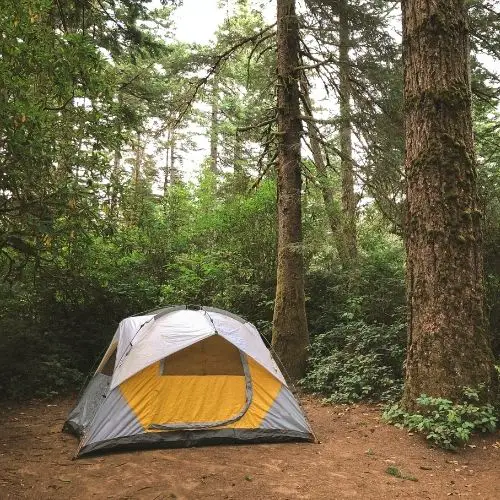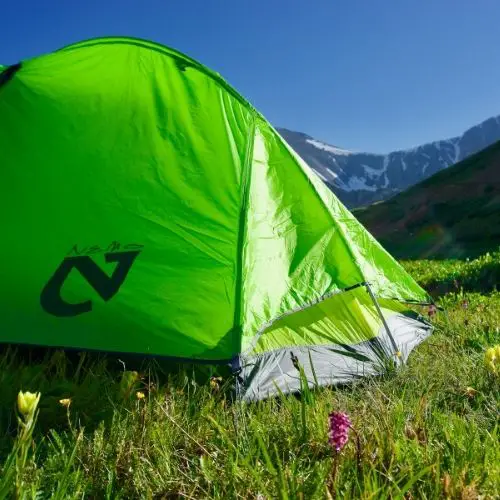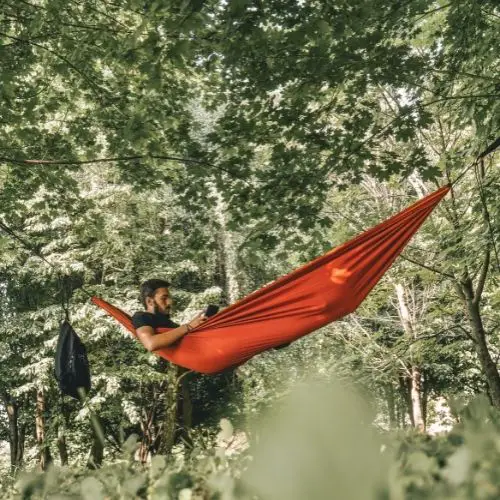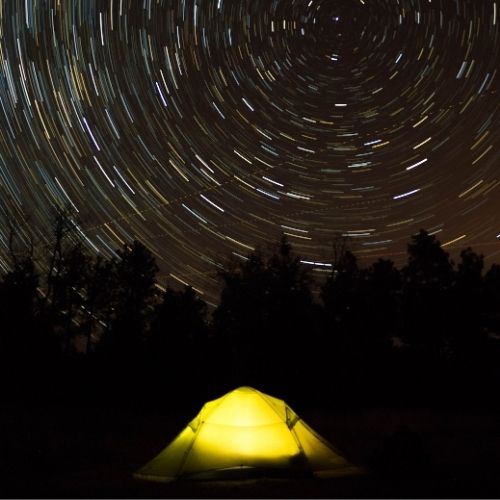We may get commissions for purchases made through links in this post. Thanks for the support! 👍
If you’re new to backpacking or hiking, you’re probably searching for a tent and confronted with the decision between a camping tent and a backpacking tent. Thus, what is the distinction?
The majority of backpacking tents weigh less than four pounds and others as low as one pound, rendering them suitable for carrying longer distances than a typical camping trip involves. Camping tents are used where little or no hiking is required and may provide additional space; however, they can weigh up to ten pounds, based on the sleeping capacity.
Another distinction between hiking and backpacking tents is the materials used to construct them. Certain backpacking tents are constructed from ultralight fabrics such as Dyneema, but these tents may be very costly, costing upwards of $500 for certain brand names.
Additionally, camping tents prefer to use thicker, longer tent poles with a greater number of them. While this adds strength to the shelter, it also adds weight compared to backpacking tents that can have a single-pole or perhaps only the hiker’s trekking poles for protection.
The distinction dividing a backpacking tent from a camping tent can become distorted by comparing a three or 4-person backpacking tent to a similar size camping tent. However, you would seldom come across a backpacking tent with a size greater than four persons. Additionally, I’ve seen some bigger backpacking tents that weigh the same as or more than comparable-sized camping tents.
When is it appropriate to use a camping tent?

Camping tents are more effective when you can travel to your campsite or if the hiking is not too strenuous. While no one wishes to lug a 12-pound tent ten miles, it has been accomplished.
Having said that, hauling such a big tent on a backpacking trip can work out well if it is designed to sleep several campers and fits comfortably inside or outside your backpack, eliminating the need for everyone to bring a tent.
If that is the case, other hikers can assist you by bearing any of your belongings to alleviate the strain of carrying such a large load.
When is it appropriate to use a backpacking tent?
When hiking many miles, a backpacking tent is the best choice. Carrying less weight benefits the body and enables you to be more flexible as necessary.
Unless you’re bringing a shared tent with many individuals, leave your camping tent at home and invest in a 1-person backpacking tent or, if you need more room, a two-person backpacking tent. Both would be a lighter option than a camping tent.
You can use a backpacking tent even though you are not camping, so unless you intend to sleep with a large group, a backpacking tent might be the superior alternative.
What are some popular tent styles?
Tents come in various types of style, but we’ll highlight a few of the more common.
- Dome – This is perhaps the most typical kind of tent you’ll see when camping or backpacking.
- A-Frame – An older type of tent with an “A” design that is still common.
- Tunnel – Constructed in the form of a tunnel or tube. More prevalent in bigger communities.
- Pop-Up – Known for their simplicity of setup, but also their lack of wind resistance.
- Walled – These tents come in various styles but usually provide more height and are suitable for extended camping stays.
- Backpacking – Maybe some variant on most of the tent types mentioned above, but would usually be lightweight and smaller.
What characteristics to aim for while purchasing a backpacking tent
When purchasing a backpacking shelter, there are a few critical features to remember. Consider the following before making a choice.
Size

You want a tent large enough to sleep the number of persons you anticipate living in it daily; thus, avoid purchasing a 4-person tent if you plan to use it just once. While most 1-person tents are adequate for one person, others may be a little claustrophobic, making a 2-person tent a safer option. Additionally, check the measurements of tents, as a three-person tent can only accommodate three small to medium-sized individuals.
Weight is the primary factor that distinguishes a backpacking tent from a camping tent, so it goes without saying that you can know the amount of weight you’ll be bearing while shopping for a backpacking tent. While the majority can mention their weights, be aware of the difference between minimum trail weight and packed weight. The minimum weight is the tent without the rainfly or other accessories, while the boxed weight includes both poles and stakes.
- Roof Top Tents: Are They Waterproof?
- Tarps and Tents: Can You Put a Tarpaulin over a Tent?
- The Only Camping Essentials Checklist You Need
Space for the Head
Many tents come with diagrams detailing their measurements, which usually involve the inside height. You want a tent with plenty of headspaces to ensure your comfort. Expect that you may not stand in a backpacking tent, but it’s advisable to have one with plenty of headspaces to sit up straight.
Three- or four-season
A 3-season tent is usually used in the spring, summer, and fall, but do not let the name trick you into believing it cannot be used in the winter. And don’t believe that a four-season tent is suitable for year-round use; in reality, they are better reserved for winter camping due to their ability to withstand snow and ice. As long as you are not anticipating significant snow or ice, a three-season tent would suffice.
What to check for when purchasing a tent for camping
Characteristics
Certain camping tents have lavish amenities that enhance the camping experience. From curtains to space dividers, awnings, and screened porches, we have it all. Others simply have a spot to sleep away from the pests and out of the shower. Naturally, more features equate to a higher price, but camp in whichever way makes you the more relaxed.
Family or Yourself
If you’re purchasing a camping tent for your family, you’ll want one large enough to accommodate everybody comfortably. Or, if you’re looking for anything exclusively for yourself, why not go for a backpacking tent? In this case, seek out a tent with a size that meets the requirements.
The Seasons
When it comes to backpacking tents, it’s best to get the ones rated for the type of weather you’ll encounter when camping. Again, if you anticipate severe winter conditions, a three-season tent would suffice.
Will you sleep or backpack without a tent?
When sleeping outside, a tent is not often required. Indeed, several hikers have completed the Appalachian Trail without carrying tents. Here are a few alternatives to tent camping.
Camp for cowboys
Cowboy camping is described as sleeping outside of a shelter. It’s just you and your sleeping pad, surrounded by beautiful stars. This is not suitable in cooler climates, and it should go without saying that you should check the forecast for the possibility of rain.
Take refuge in a shelter.
Individuals have hiked the entire Appalachian Trail without even setting up a shelter. They do this by hiking through shelters, which may be dangerous if you arrive late and the shelter is already complete. However, this is an alternative if the area where you want to camp has a shelter. If you are unsure, do study or play it safe by bringing a shelter.
Use a certain kind of shelter.

There are alternatives to having a shelter for protection from the elements. Of course, as discussed before, living in a shelter is not an “alternative shelter,” although you may follow some of the approaches listed below.
- Tarp Shelter – This type of shelter may be constructed with either dedicated camping tarps or inexpensive blue tarps. Tarps come in a variety of shapes and can be modified and hung in a variety of ways. However, if you do not have any kind of nets to keep the bugs away, you would be vulnerable to them.
- Hammocks – Although hammocks do not provide cover, they may be used in conjunction with a tarp hanging overhead to provide cover from the weather. Many people assert that hammocks are far more relaxing than sleeping on the ground, although this is subjective and dependent on your personal tastes.
- Bivy Sack – Bivy sacks are small shelters designed to accommodate just the body. Some are available; some are waterproof, while others are just screens to keep out insects. A tarp may be hung over a bivy sack if you need additional space to layout your gear while also keeping it dry or if you just want a bit more protection when changing clothing.
- Bushcraft Shelter –This is constructed from items found in the wild, although it is not recommended for backpacking or hiking since it requires much longer to build up and can be environmentally unfriendly due to the possibility of sawing limbs or destroying any nearby vegetation.
Conclusion
Hopefully, you now understand the primary distinctions between camping and backpacking tents and have a better idea of which style of tent is better tailored to your needs. What are you asking for, then? Get outside to admire the great outdoors in your soon-to-be-purchased shelter.
![Can Camping Chairs Get Wet? [6 Examples]](https://amanandhisgear.com/wp-content/uploads/2020/10/Can-camping-chairs-get-wet_.jpg)

![You Need A Camping Journal [What Is It, And Why?]](https://amanandhisgear.com/wp-content/uploads/2020/10/Journal-and-notes.jpg)
